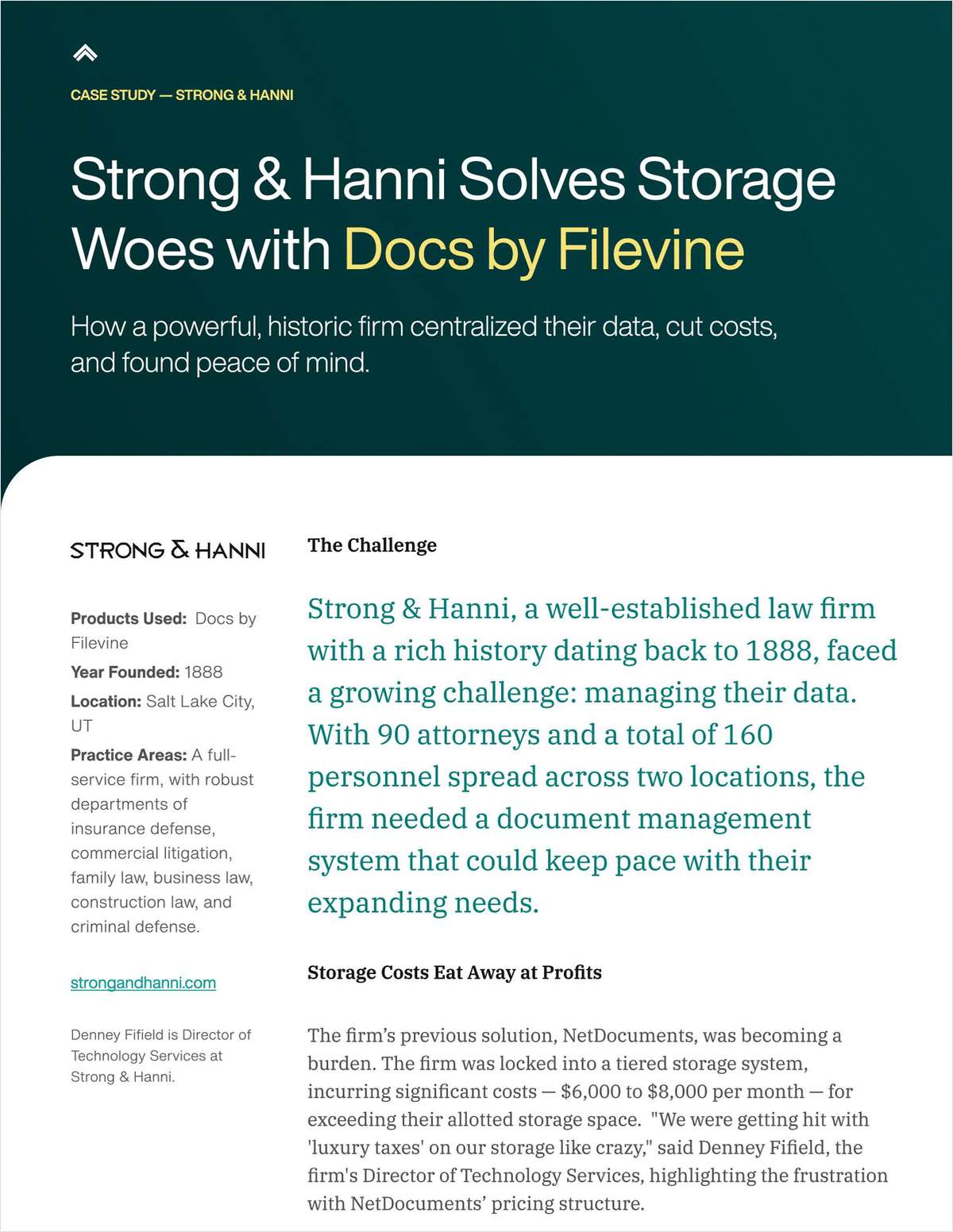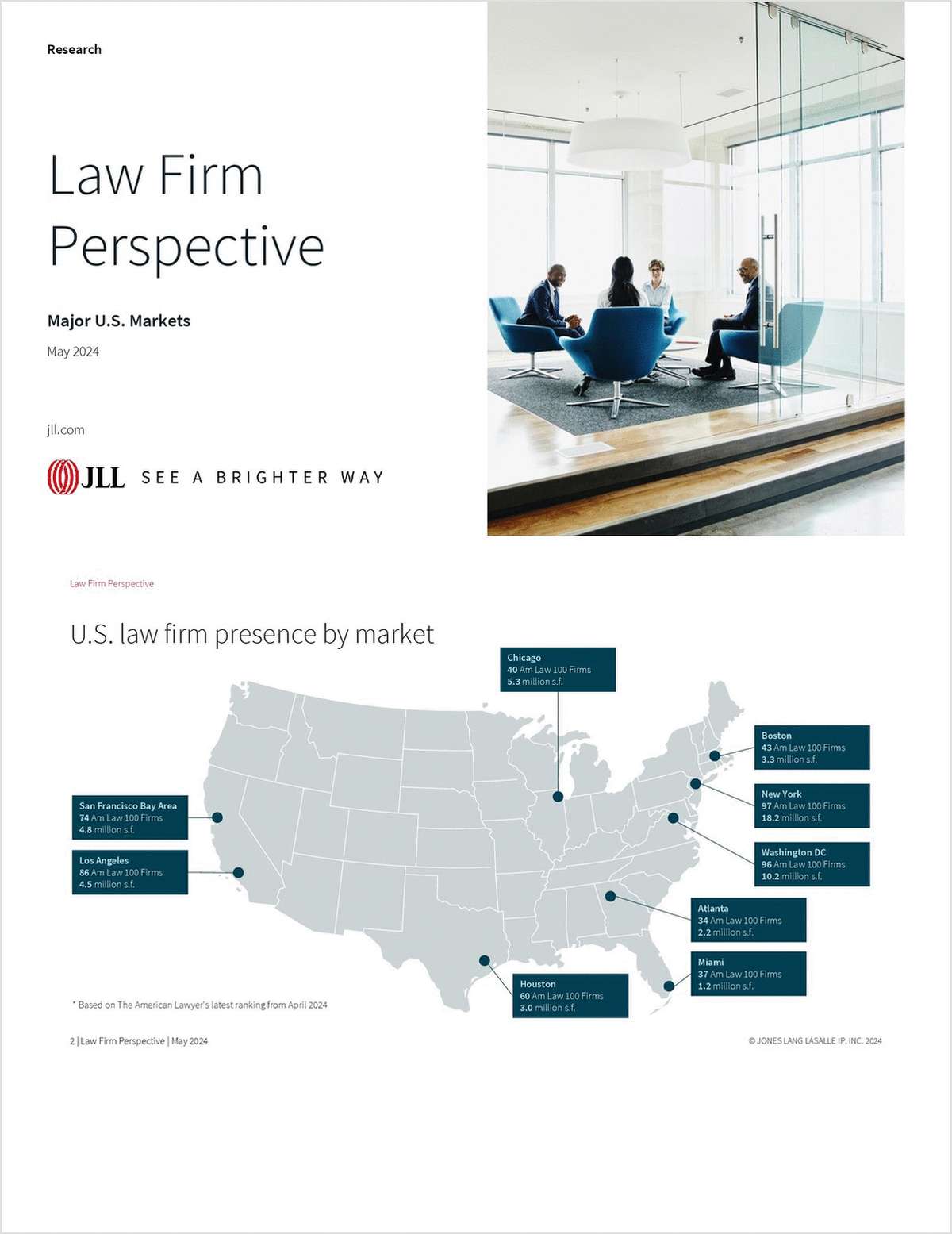Law Firms Just Turned in Their Best Half Since the Recession
Revenue growth of 5.5 percent in the first half of 2018 was the highest since 2007, and the outlook going forward remains positive.
August 19, 2018 at 08:00 PM
8 minute read

Historically strong revenue growth on the strength of a pickup in demand and solid rate increases, together with moderate expense growth through the first half of 2018, have the law firm industry well ahead of last year's first-half performance. However, behind the industry averages, we continued to see dispersion across the industry, with the market favoring the largest and smallest firms during the first half. Looking ahead, the revenue outlook for the rest of 2018 is very positive, with a solid buildup in inventory heading into the third quarter. The industry will need this, given the upward pressure on expenses we expect to see in the second half of the year as firms absorb the recently announced salary increases.
These results are based on a sample of 186 firms (77 Am Law 100 firms, 53 Second Hundred firms and 56 niche/boutique firms). Thirty-six of these firms fit our definition of either “international” (between 10 and 25 percent of lawyers based outside the United States), or “global” (at least 25 percent of lawyers based outside the United States). Firms with less than 10 percent of lawyers based outside the U.S. are classified as either “national” (less than 50 percent of total lawyers based in headquarters office), or “regional” (greater than 50 percent of lawyers based in headquarters office).
Citi Private Bank provides financial services to more than 600 U.S. and U.K. law firms and more than 35,000 individual lawyers. Each quarter, the Law Firm Group confidentially surveys firms in the Am Law 100 and the Second Hundred, along with smaller firms. In addition, we conduct a more detailed annual survey and produce the Law Firm Leaders Confidence Index semiannually. These reports, together with extensive discussions with law firm leaders, provide a comprehensive overview of current financial trends in the industry as well as forward-looking insight.
Revenue growth of 5.5 percent was greater than the 4.9 percent seen during the first half of last year, the strongest result we've seen since 2007. Improved demand (total timekeeper hours) and lawyer billing rate increases were the main drivers of this growth. In fact, we saw some of the strongest growth results we've seen in years. Demand increased by 2 percent and was the strongest result we've published since the first half of 2007. The lawyer billing rate increase of 4.5 percent was the strongest result we've published since the first half of 2008.
The only drag on results was a 2.4 percent lengthening of the collection cycle, which was due in part to the accumulation in inventory arising from the pickup in demand. Although this slowdown tempered revenue growth, the resultant 8 percent buildup in inventory—well-balanced between 8.3 and 7.8 percent increases, respectively, in accounts receivable and unbilled time—puts the industry in a good position for decent collections in the third quarter and beyond.
Lawyer head count grew 1.8 percent, slightly less than during the first half of last year. That growth came from the addition of salaried lawyers, as equity partner head count declined by 0.5 percent. This continued a seven-year trend of actively managing equity partner head count while increasing leverage.
Expense growth moderated through the first six months—up 4.8 percent compared to 5.1 percent last year. While operating expense growth was stronger than during the first half of last year, lawyer compensation expense slowed. Of course, with the recent associate salary increases adopted by many in the industry, we would expect to see upward pressure on expenses through the second half of this year.
Behind the industry averages, we continued to see performance dispersion. The good news was that a greater proportion of firms reported growth in demand in the first half of 2018 compared with the first half of 2017, 55 versus 52 percent, although we continued to see volatility. To measure volatility in demand performance, we looked at the 145 firms that reported first-half results in 2016, 2017 and 2018. Approximately 44 percent of these firms either saw demand increase in the first half of 2017 and decrease in the first half of 2018, or vice versa. Furthermore, a quarter of firms saw demand decline in both periods. The prolonged period of performance dispersion and ongoing volatility that we've witnessed in the industry will likely lead to continued consolidation in the years ahead.
Dispersion was also evident when we looked at the results by revenue size. Among the Am Law segments, size mattered, with Am Law 50 firms outperforming the other market segments in the first half of the year, continuing a general trend we've seen over the past couple of years. They posted the strongest increase in revenue (6.8 percent), driven by the largest increases in both demand (3.2 percent) and lawyer billing rates (4.8 percent). Furthermore, they enjoyed the greatest improvement in lawyer productivity, despite increasing lawyer head count the most. They are also poised to have the best collections in the foreseeable future, with a 10.1 percent increase in inventory at the end of the first half of the year.
The Am Law 51 to 100 firms were second to Am Law 50 firms in revenue growth (3.7 percent), as well as demand, rate, productivity, head count and inventory growth. On the other hand, the Second Hundred firms continued to struggle, as they have since the beginning of last year. Revenue was up only 1.3 percent, as a decline in demand tempered an increase in lawyer billing rates. Lawyer productivity also declined and inventory was up only 0.6 percent, suggesting that revenue growth will remain a challenge in the near term. Furthermore, this was the only segment for which expense growth exceeded revenue growth.
Outside the Am Law 200, we saw strong performance by niche/smaller firms. In fact, they actually posted slightly stronger revenue growth (6.9 percent) than Am Law 50 firms. Their demand and billing rate increases of 1.6 percent and 3.6 percent, respectively, trailed only the Am Law 50 firms, and they also benefited from improved collections. Furthermore, despite strong collections, they still had a healthy 5.3 percent increase in inventory heading into the second half of the year.
Looking at firms by geographic reach, revenue performance was strongest among global firms (8.1 percent), and was more modest as firms became more U.S.-centric. Global firms also experienced the strongest increases in demand (3.4 percent) and lawyer billing rates (5.6 percent), although all segments enjoyed growth in both. Although the global firms managed the strongest growth in revenue, they also saw the greatest growth in expenses (8 percent), driven by strong growth in both operating expenses and compensation expenses. And while International firms trailed global firms in revenue growth (reporting 7 percent growth), they saw much lower expense growth (5.5 percent growth). As a result, while global firms outpaced the other market segments in terms of revenue growth, International firms actually enjoyed the best margin growth.
As we look ahead to the second half of 2018, revenue growth is likely to remain strong, provided the improvement in demand continues and a large portion of existing inventory gets converted into cash. The only factors that would seem to prevent full-year 2018 profitability from improving on 2017 would be the relatively high demand hurdle arising from the surge in fourth-quarter demand last year, as well as upward pressure on expenses. Lawyer compensation expenses in particular are poised to increase, driven by the growth in salaried lawyer head count and exacerbated by summer bonuses and another round of salary increases at many firms (similar to mid-2016). While we would expect overall profitability to ultimately improve over last year, continued dispersion and volatility in the results suggest that the larger firms will outperform the others, often at the expense of the smaller firms, consolidating their already strong market position in the process.
John Wilmouth is a senior client adviser in Citi Private Bank's Law Firm Group, and Gretta Rusanow is Head of Advisory Services. Citi Private Bank is a business of Citigroup Inc., which provides its clients access to products and services through bank and nonbank affiliates of Citigroup. Not all products and services are provided by all affiliates or are available at all locations. The views expressed herein are for informational purposes only and are those of the authors and do not necessarily reflect the views of Citigroup Inc. All opinions are subject to change without notice.
This content has been archived. It is available through our partners, LexisNexis® and Bloomberg Law.
To view this content, please continue to their sites.
Not a Lexis Subscriber?
Subscribe Now
Not a Bloomberg Law Subscriber?
Subscribe Now
NOT FOR REPRINT
© 2024 ALM Global, LLC, All Rights Reserved. Request academic re-use from www.copyright.com. All other uses, submit a request to [email protected]. For more information visit Asset & Logo Licensing.
You Might Like
View All
HSF's American Dream: What Will a U.S. Merger Mean For its Asia Practice?

Trending Stories
- 1Gibson Dunn Sued By Crypto Client After Lateral Hire Causes Conflict of Interest
- 2Trump's Solicitor General Expected to 'Flip' Prelogar's Positions at Supreme Court
- 3Pharmacy Lawyers See Promise in NY Regulator's Curbs on PBM Industry
- 4Outgoing USPTO Director Kathi Vidal: ‘We All Want the Country to Be in a Better Place’
- 5Supreme Court Will Review Constitutionality Of FCC's Universal Service Fund
Who Got The Work
Michael G. Bongiorno, Andrew Scott Dulberg and Elizabeth E. Driscoll from Wilmer Cutler Pickering Hale and Dorr have stepped in to represent Symbotic Inc., an A.I.-enabled technology platform that focuses on increasing supply chain efficiency, and other defendants in a pending shareholder derivative lawsuit. The case, filed Oct. 2 in Massachusetts District Court by the Brown Law Firm on behalf of Stephen Austen, accuses certain officers and directors of misleading investors in regard to Symbotic's potential for margin growth by failing to disclose that the company was not equipped to timely deploy its systems or manage expenses through project delays. The case, assigned to U.S. District Judge Nathaniel M. Gorton, is 1:24-cv-12522, Austen v. Cohen et al.
Who Got The Work
Edmund Polubinski and Marie Killmond of Davis Polk & Wardwell have entered appearances for data platform software development company MongoDB and other defendants in a pending shareholder derivative lawsuit. The action, filed Oct. 7 in New York Southern District Court by the Brown Law Firm, accuses the company's directors and/or officers of falsely expressing confidence in the company’s restructuring of its sales incentive plan and downplaying the severity of decreases in its upfront commitments. The case is 1:24-cv-07594, Roy v. Ittycheria et al.
Who Got The Work
Amy O. Bruchs and Kurt F. Ellison of Michael Best & Friedrich have entered appearances for Epic Systems Corp. in a pending employment discrimination lawsuit. The suit was filed Sept. 7 in Wisconsin Western District Court by Levine Eisberner LLC and Siri & Glimstad on behalf of a project manager who claims that he was wrongfully terminated after applying for a religious exemption to the defendant's COVID-19 vaccine mandate. The case, assigned to U.S. Magistrate Judge Anita Marie Boor, is 3:24-cv-00630, Secker, Nathan v. Epic Systems Corporation.
Who Got The Work
David X. Sullivan, Thomas J. Finn and Gregory A. Hall from McCarter & English have entered appearances for Sunrun Installation Services in a pending civil rights lawsuit. The complaint was filed Sept. 4 in Connecticut District Court by attorney Robert M. Berke on behalf of former employee George Edward Steins, who was arrested and charged with employing an unregistered home improvement salesperson. The complaint alleges that had Sunrun informed the Connecticut Department of Consumer Protection that the plaintiff's employment had ended in 2017 and that he no longer held Sunrun's home improvement contractor license, he would not have been hit with charges, which were dismissed in May 2024. The case, assigned to U.S. District Judge Jeffrey A. Meyer, is 3:24-cv-01423, Steins v. Sunrun, Inc. et al.
Who Got The Work
Greenberg Traurig shareholder Joshua L. Raskin has entered an appearance for boohoo.com UK Ltd. in a pending patent infringement lawsuit. The suit, filed Sept. 3 in Texas Eastern District Court by Rozier Hardt McDonough on behalf of Alto Dynamics, asserts five patents related to an online shopping platform. The case, assigned to U.S. District Judge Rodney Gilstrap, is 2:24-cv-00719, Alto Dynamics, LLC v. boohoo.com UK Limited.
Featured Firms
Law Offices of Gary Martin Hays & Associates, P.C.
(470) 294-1674
Law Offices of Mark E. Salomone
(857) 444-6468
Smith & Hassler
(713) 739-1250












